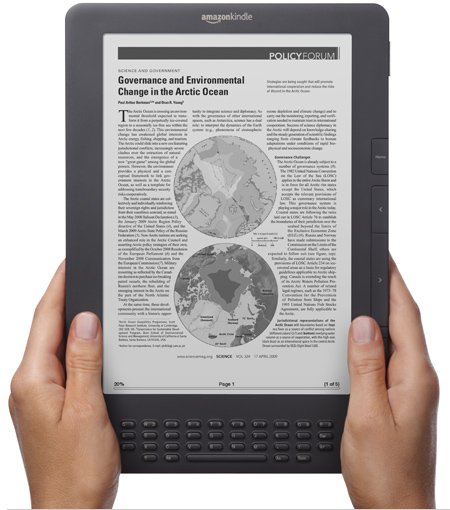Amazon Releases Cheaper Kindle DX
A year after releasing the original Kindle DX with a 9.7-inch screen, Amazon.com has replaced it with an enhanced model that features a graphite-colored case, a higher-contrast E Ink screen, and a lower price.
The graphite case of the new Kindle DX is a minor change, swapping the white plastic of the original for a dark grey. Perhaps it hides dirty fingerprints better, or perhaps it’s just a cosmetic change to differentiate the device from the original. It has also been suggested that the darker frame may help emphasize text and graphics on the higher contrast screen.
Speaking of which, Amazon touts the new E Ink screen as having “50 percent better contrast for the clearest text and sharpest images.” Without color, improved contrast will help make black-and-white text and images be more readable. As people start comparing the Kindle DX with the color-screened iPad, anything Amazon can do to improve the Kindle’s E Ink display will help.
Unsurprisingly, Amazon also lowered the Kindle DX’s price from $489 to $379, creating a noticeable spread between it and the $499 iPad. This move follows Amazon’s recent price reduction on the smaller Kindle 2, dropping its price from $259 to $189. That move was prompted by Barnes & Noble dropping the price of the Nook ebook reader from $259 to $199. The Kindle DX may be pre-ordered now, with a promised ship date of 7 July 2010.
Otherwise, the Kindle DX’s features remain unchanged, with free 3G wireless connectivity for downloading books from Amazon’s Kindle Store, Whispersync synchronization of libraries and reading position across multiple devices, long battery life rated at 1 week with wireless on or 2 weeks with wireless off, horrid little keyboard, text-to-speech capabilities, basic PDF capabilities (links and bookmarks aren’t supported), and an auto-rotating screen. Amazon says the Kindle Store now contains over 620,000 titles along with 1.8 million out-of-copyright books from before 1923.
Although many existing Kindle owners remain happy with their devices, speaking as someone who owns two Kindles and an iPad, the Kindle and Kindle DX sit entirely unused while the iPad receives frequent attention. The Kindle advantages of long battery life, being readable in bright sunlight, significantly larger store (perhaps 10 times as many titles at the moment), and slightly lighter weight simply don’t compete with the iPad’s capabilities for us. Perhaps the Kindle’s weight and battery life advantages would be more important for those who travel constantly or who have a long commute.
Our preference is largely due to the iPad being vastly more capable beyond ebook reading, thanks to its thousands of apps, full Internet access, and text-input capabilities, but even within the realm of ebooks, the iPad’s fast color screen, which doesn’t suffer from annoying delays on every page turn, makes for a better experience in our usage.
Sales figures would seem to support our opinion. I’ve now seen estimates that Amazon has sold 3 million Kindles since the device’s introduction in 2007. That’s not bad, of course, but it pales in comparison with the 3 million iPads that Apple sold in the first 80 days after its release.
Still, with free Kindle apps being available for the iPad, iPhone, Android, BlackBerry, Mac, and Windows, it’s easy to see Amazon hedging its bets by creating a market for ebooks along with ebook reading devices.

For someone who reads-reads, the difference is astounding. I've been reading ebooks on various platforms, and until Christmas, the best was my iPhone, with the brightness turned way way down. NOW, my best is my Nook, solely because of the eInk screen. There really is no comparison between a backlit and reflective screen for long reading sessions, but unfortunately, this isn't apparent until AFTER the long reading sessions. If the eInk readers can get over that barrier, then I think the contest will be done -- people who want to read articles will use an iPhone/iPad, and people who want to read books will use an eReader.
I really think this is just a matter of personal preference - I spend vast amounts of time every day reading from my Mac's LCD displays, with no particular eyestrain. I find the E Ink screens fine to look at, but I truly detest the page-flipping lag time; it's a constant irritation.
I have been wondering from the beginning why the Kindle was white, since it just highlights that the screen is nowhere close to white, or even light-grey.
And perhaps a darker frame even helps the reading experience by making the eyes' iris open slightly more, helping the mid-grey screen seem lighter.
I wonder *how* much better the contrast is with the new DX, since apart from the slowness, the low contrast (dark background) was my biggest issue with the Kindle.
Oh, that's an interesting point. Visual perception is extremely context-sensitive, and wrapping the Kindle E Ink screen in dark plastic may significantly affect how people perceive the type contrast.
two big reasons ,I prefer kindle
1. I like to read outside
2. I like to choose what I read without having apple decide I shouldn't read something.
The second reason is also why I would never own an iPad
I've never understood the outside thing. Perhaps I'm weird, but where I live, outside means too hot or too cold, too bright or too dark, too buggy in the summer (and completely impossible the other 9 months of the year), and far less comfortable (my cheap deck furniture doesn't begin to compare with carefully chosen living room furniture).